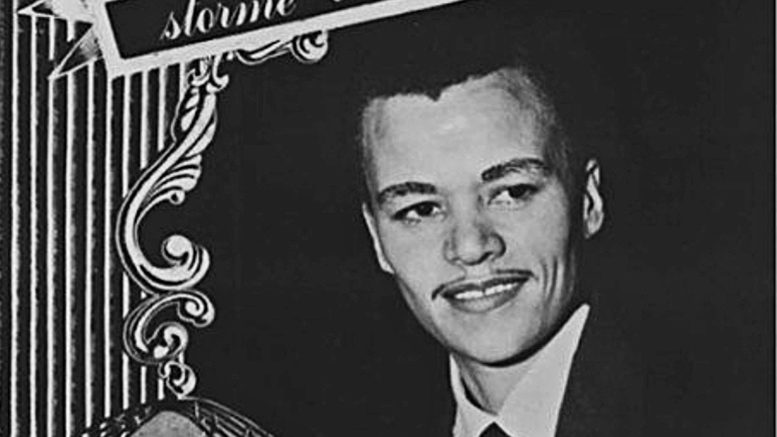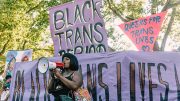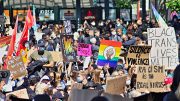The “Holy Trinity” of Stonewall–Marsha P. Johnson, Stormé DeLarverie, and Sylvia Rivera!
By: Ben Power*/Special to The Rainbow Times—
History is but storytelling. Who tells our queer and trans stories? Let it be we and let our stories be true.
Ever in my memory is an incident in the late 1960s in Chicago when I was in my teens. I started going to lesbian, gay, leather, and drag bars before I could legally drink, searching for someone–anyone–who was like me: a semi-homeless, working-class transgender boy completely alone with no words yet for who I was. This bar, the Lost & Found, had opened on Chicago’s north side in 1965, just after I turned 15. It was a blue-collar, heavily wood-paneled dyke bar but gender non-conforming stones like me from the poor class, gay men, drag queens and kings all sought community there.
The windows on the place were dark so no one could see inside. The locked and heavy wooden door had a small, circular window out of which the bouncer checked before letting you inside. No one who looked straight got in–and no cops, either. Behind the door of the Lost & Found was the entire queer world, to me. It existed only within the confines of that space and did not exist anywhere in society outside of it. The minute the door opened and I stepped inside that smoked-filled bar, I crossed over into the world of my people. If only for a fleeting couple of hours, I left Planet Cis Heterosexual behind.
It may be hard for young people to imagine today, but a queer bar was the only place we could see each other back then. We had a blast there, meeting others like ourselves for the first time or dancing with friends or lovers, but it was fraught with fear and danger, too–secretive clubs were a collective closet.
A lesbian-owned the Lost & Found, but the Mafia working with the Chicago PD shall we say, regularly “managed” the place.
There were state laws against cross-dressing. Stones who came in wearing front-zippered pants had to take them off and put them on in reverse, with the zipper in the back, if trouble arose. Under the law, a person must wear at least three articles of clothing that matched their gender assigned at birth. It was illegal to “conceal one’s sex in public.” Police harassed lesbians and gay men just for dancing with each other, but patrons of the bar whose skin was dark or whose clothing was gender non-normative were the biggest targets. Not until 1973 was the anti-crossdressing law in Illinois struck down.
What I remember at the Lost & Found was a large brick crashing through the front window. This was the Mafia intimidating the bar owner into paying up–or else. The “or else” was the cops responding to the shattered glass, and thus ensued a raid where patrons were terrorized, busted for gender non-conforming attire or same-sex touching, verbally abused with homophobic slurs by the cops, roughed up and beaten when they resisted arrest. That night, I saw butches and drag queens chew up and swallow their paper drivers’ licenses to protect their identities, and then give the cops fake names so they could not be outed to their families or employers. I was among the lucky ones who ran downstairs to the bar’s basement and escaped the cops, making our exit into the alley.
Police raids were a war waged against queer and trans people nightly at bars across the U.S. in the 1960s and for decades before. We were the downtrodden; ever living on the edge of society with laws against us, risking harassment or arrest just for being ourselves and reaching out for love.
A few years after the Lost & Found raid, we heard in Chicago that a scene like this had a very different outcome at a bar in NYC. Ever since 1969, when I heard news about my queer and trans people rioting in rage and resistance, I have been in a Stonewall State of Mind.
“Stonewall” Means “To Resist”
Planet Cis Het waged another routine police raid against poor drag and trans people primarily of color and young working-class gays and lesbians in the early morning hours of Friday, June 28, 1969–at a gritty, local dive in Greenwich Village at 53 Christopher Street, the Stonewall Inn. The bar catered to diverse patrons including the poorest and most marginalized people in the gay community, drag queens, transgender people, effeminate young men, butch lesbians, male prostitutes, and homeless youth.
At the time, the Stonewall Inn was Mafia-owned; its financial relationship with the NYPD solidified repeat oppression against its customers. When the NYPD was unable to get kickbacks from blackmail of wealthier customers at the bar, they decided to close down the place. However, to many of the “street kids,” the Stonewall was their home. They fought back to keep it.
Four plain-clothes cops in dark suits and two patrol officers in uniform made the raid. When the uniformed cops arrived at the door, they yelled, “Police, we’re taking the place!” Over 200 people were inside the Stonewall. As usual, cops lined up men dressed as women and women dressed as men, and invasively checked their bodies for their biological sex, then arrested them. Scores of patrons escaped outside and gathered in front of the bar, shouting “Gay Power!” and singing “We Shall Overcome.”
As if history had named the place itself, the word “stonewall” means “to block, to resist.” And resist they did! Outbreaks of violent demonstrations lasted through that night and the next, and erupted again a few nights later.
What was different about a police raid this time was our response to it. Straight society for decades thought of homosexuals as meek and mild people who kept their heads down quietly or lived in the closet in fear. Bigots considered their loving nature to be an immutable weakness. The Stonewall riots broke that stereotype. This time, trans and queer people, fed up with oppression, waged a furious physical fightback against the cops. The intensity and duration of their resistance was new and reverberated throughout the nation and the world.
At Stonewall, hundreds of queer and trans people fought the police with their fists and thrown objects. They pulled up a parking meter and used it to barricade police inside the bar, started fires, and damaged cars and property as crowds of 500 to 1,000 people rioted in the surrounding streets. Stonewall was the flashpoint that gave painful birth to the modern LGBTQ Rights Movement. For a complete history, see the Wikipedia page (https://is.gd/wikiStonewall), “Stonewall riots.”
This was not the first street protest or group resistance by trans and queer people in the United States. In May 1959 at Coopers Do-nuts in Los Angeles, in response to police harassment, trans women, drag queens, lesbians, and gay men pelted the cops with donuts and hot coffee cups. On April 25, 1965, queer people of color, many of them cross-dressed, staged the Philadelphia Lunch Counter Sit-in in protest of denial of service there. Homosexuals and lesbians organized the Annual Reminder Day pickets each Fourth of July from 1965 to 1969 at Independence Hall in Philadelphia and outside the White House in Washington, DC, protesting against employment discrimination and inequality. On July 18, 1966, a picket by trans women of color and queers over denial of service at Compton’s Cafeteria in San Francisco and arrests of males dressed as women resulted in a riot against police harassment. The rioters shattered the windows of the restaurant and damaged property in the surrounding neighborhood. For a complete list, see the Wikipedia page (https://is.gd/e2B8OT) “List of LGBT actions in the United States prior to the Stonewall riots.”
The Stonewall Rebellion took place in NYC in the spotlight of the U.S. national media. Perhaps wide attention to the rioting made Stonewall the tipping point into a LGBTQ Rights Movement that continues to this day.
To put Stonewall in context, the 1960s was a decade of protest and movement- formation on all fronts. The Black Civil Rights Movement, the anti-Vietnam War Movement, the Women’s Liberation Movement were all engaging in organized or spontaneous demonstrations in U.S. streets. All Americans, including LGBTQs, had watched the Watts riots on TV. Chants of “Black Power!” led to “Gay Power!” Slogans such as “Black is Beautiful!” helped conceptualize “Gay is Good!” In shouts of “Gay Pride!” echoed “Black Pride!” Many, if not all, of the Stonewall rioters were already activists in the great social justice movements of the day.
Shine the Spotlight of History on Stormé DeLarverie
Despite early attempts at whitewashing the history of who the pivotal actors were at Stonewall into a false narrative of white gay men leading the charge, eventually the truth emerged. Historical facts continue to surface.
Marsha P. Johnson, a black transgender woman, is now widely recognized as the person who threw the first object outside the Stonewall, igniting the physical fightback against the police.
Sylvia Rivera, a Puerto Rican / Venezuelan drag queen, was not present on the first night of Stonewall but participated in the riot on ensuing nights. Today considered the Mothers of the Transgender Movement, Sylvia and her friend Marsha worked tirelessly for street trans people and incarcerated trans women. Rivera was initially active in the Gay Liberation Front and the Gay Activist Alliance before forming her own organization in 1970, S.T.A.R. (Street Transvestite Actions Revolutionaries), to help homeless transgender women in NYC.
But what exactly happened at the Stonewall to so enrage the crowd?
Queer and trans historians have for decades noted that a black stone butch lesbian, cross-dressed in a man’s leather jacket and pants, was at the center of the uprising. After a long time of speculation about the identity of this person, today we know that this was Stormé DeLarverie.
Stormé DeLarverie (1920 – 2014) was a black drag king who frequently cross-dressed off the stage as well. During the 1950s and 1960s, DeLarverie was part of the legendary drag troupe, The Jewel Box Revue. About 25 men performed in women’s clothes, and she, the only female in the troupe, performed dressed as a man. In an era still marked by segregation, the Revue featured both black and white performers and attracted a mainstream mixed-race crowd, playing regular shows at the Apollo Theater and traveling the country to perform in major cities. Even after the group disbanded, it continued to live on in popular culture.
Quite a few friends, eyewitnesses, and historians over the years have identified DeLarverie as the tough cross-dressing dyke handcuffed and clubbed by the NYPD, which evoked enough outrage to spur the crowd to action. Charles Kaiser identified DeLarverie as the Stonewall Lesbian in his book, The Gay Metropolis. The New York Times a few times mentioned her scuffle with the police at Stonewall. Then in the January 2008 issue of Curve Magazine in a detailed interview with Patrick Hinds, DeLarverie identified herself as the Stonewall Lesbian and finally took credit for catalyzing the riot. She said,
“[The officer] then yelled, ‘I said, move along, faggot.’ I think he thought I was a boy. When I refused, he raised his nightstick and clubbed me in the face. It was then that the crowd surged and started attacking the police with whatever they could find.”
The cop clubbed DeLarverie for, as one witness claimed, complaining that her handcuffs were too tight. Bystanders recalled that DeLarverie sparked the crowd to fight when she looked at bystanders and shouted, “Why don’t you guys do something?” After an officer picked her up and heaved her into the back of the patrol wagon, the crowd became a mob; it was at that moment that the scene became explosive. For more information, see https://is.gd/iFmggD.
All hail the Holy Trinity of Stonewall–Marsha P. Johnson, Stormé DeLarverie, and Sylvia Rivera! All three were visibly gender non-conforming people of color attacked by the cops for their non-binary gender expression and their race. Did the officers stop to ask them what their sexual orientation was? Almost certainly not, but were hostile to them as “faggots” or “queers.” Can we not see that Stonewall was as much, if not more, of a transgender uprising as it was a gay and lesbian one? Gays and lesbians joined in on the melee but trans people of color were the first warriors outside the Stonewall, sparking our freedom movement against oppression.
Stonewall Now!
The Stonewall Inn was a building–a place where we could be ourselves. No community can exist without a space in which to do so. Stonewall was also an uprising, a rebellion, and a riot. Stonewall ultimately was our Revolution, the action that asserted our human rights.
Most schools do not teach the history of Stonewall. Most youth have never heard of it, or if they have, they do not know that it was a riot. Commercialized Prides continue to obscure our angry, activist past. It is not in the interest of a capitalist, racist, patriarchal country to provide information about a working-class, queer rebellion.
In this era of Trumpism when trans and queer rights are being reversed or denied, it is more important than ever to teach the facts about the Stonewall Rebellion and to take action in a Stonewall state of mind!
*Ben Power Alwin is the executive director of the Sexual Minorities Educational Foundation, Inc. and the curator of the Sexual Minorities Archives (https://is.gd/smaBPow).
[This story was originally published in the June 1, 2019 issue of the New England Pride Guide 2019].







